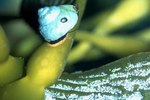
While hundreds of species of snail are spread across North America, the ones humans most typically encounter are those who live and feed in gardens, like the brown garden snail and the white garden snail. Snails like these share common eating habits that wreak havoc in gardens and destroy crops while you sleep.
Feeding Time
Snails prefer dining at night to coming out in the harsh light of day, which means you may wake up to find evidence of nocturnal feeding in your garden. When the sun is out, snails find hiding places away from its harsh light. When it's cloudy, rainy or foggy, though, they will break their habit of nighttime feeding and come out to eat during the day. Much like slugs, snails need moist environments to survive; direct sunlight can cause them to dry out to an unhealthy degree.
Succulent Plants
These mollusks are generally indiscriminate eaters, chewing up leaves, flowers and branches; they demonstrate a particular tendency to eat soft, moist and succulent plants. Ripening fruits like tomatoes and strawberries, for example, are common targets for snails. They favor vegetables like cucumbers and head cabbage. The succulence of these and other foods aren't all that they have in common, though -- these plants grow close to the ground, making them easily accessible to snails.
Tree Damage
While these creatures live primarily on the ground, they are capable of scaling vertical surfaces in search of food. This means that not only young and grounded plants but also larger trees are vulnerable to the hungry snails. Snails eat the roots, leaves and bark of trees, particularly when they are softened by the moisture that is so hospitable to these dampness-loving pests. Trees that are already in a state of decay, for example, are particular favorites of snails.
Identifying Slug Damage
The eating habits of snails are evident in the signs they leave behind after a night of feeding. Because they are nocturnal, you may not always catch snails in the act, but you can see how they feed on your crops by monitoring the signs. For example, they leave behind small, irregularly shaped and smooth-edged holes in crops. These holes are particularly noticeable in leaves. Snails also leave trails of mucus in their wake, which dries into a conspicuous silver color. These trails are consistent enough that you can follow them to find where the snails are hiding during the day and remove them.
References
- University of Vermont Extension: Department of Plant and Soil Science: Slugs and Snails
- Univeristy of California Agriculture and Natural Resources: Statewide Integrated Pest Management Program: Snails and Slugs
- Texas A&M Agrilife Extension: Snails and Slugs
- Virginia Tech Cooperative Extension: Freshwater Snail Biodiversity and Conservation
Photo Credits
-
Photos.com/Photos.com/Getty Images
Writer Bio
Tom Ryan is a freelance writer, editor and English tutor. He graduated from the University of Pittsburgh with a degree in English writing, and has also worked as an arts and entertainment reporter with "The Pitt News" and a public relations and advertising copywriter with the Carnegie Library of Pittsburgh.



